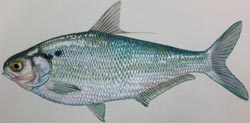Next-generation gene sequencing technology can identify invasive carp species in Chicago area waterways

Gizzard Shad <br>
The work, funded through the U.S. Environmental Protection Agency Great Lakes Restoration Initiative, is being conducted by researchers from the University of Illinois at Urbana-Champaign and the U.S. Geological Survey (USGS).
Asian carp is a term used to refer to several invasive fish species including silver, bighead and black carp. Bighead carp and silver carp have already invaded much of the Mississippi River basin, where they compete for food with native species and dominate aquatic communities. Bighead carp and silver carp are considered one of the most severe aquatic invasive species threats facing the Great Lakes today, according to the Asian Carp Regional Coordinating Committee (ACRCC).
The ACRCC is coordinating the efforts of federal, state, local and private resource management agencies to develop an Asian carp control program. Efforts to control the fish include research to understand their physiology and behavior and how they differ from that of native species, with an eye toward developing effective monitoring and management systems.
Gut microbiota—the microbial communities present in the digestive tracts of living things—are unique, according to Wen-Tso Liu, co-author of the study and a professor of civil and environmental engineering at Illinois. For that reason, careful analysis of fish gut microbiota can reveal host-specific biomarkers shed in fish feces that indicate the presence of a specific species, promising the development of precise monitoring systems. Since fish feces are plentiful in waterways, monitoring could be easier than with techniques that have focused on detecting the DNA of the targeted species in sloughed-off skin tissue, Liu says.
The researchers used a next-generation gene sequencing technology called 16S pyrosequencing, which focuses on the 16S rRNA gene sequences, to analyze the gut microbiota of the invasive silver carp and the native gizzard shad. They successfully discovered potential biomarkers for silver carp and are working to refine them, Liu says.
In addition, the research illuminated some important similarities and differences in the species. For example, he says, gizzard shad harbor microbial communities that are 10 times more diverse than that of silver carp, showing that their digestive processes are significantly more complicated. The researchers also discovered a common food-source microbe, which proves that the fish compete for the same food.
“This is why invasive species can be dangerous,” he says. “They can eat the same food, and if the invasive species consumes more food, then the native species can be out-competed and their population will start to decline, leading to ecological disaster.”
On the strength of these findings, the researchers are beginning an extensive project to confirm their findings in the fish species in the Chicago River—approximately 50 different ones—in order to map their gut microbiota and develop biomarkers for each species. The results will lead to a precise monitoring methodology, but the benefits will likely extend further, Liu says.
“There is a lot more beyond just monitoring,” Liu says. “We will also learn more about the diversity of fish, their diets, how their diets are related to their gut microbiota and how they metabolize inside the gut.”
The scientific article, “Fish gut microbiota analysis differentiates physiology and behavior of invasive Asian carp and indigenous American fish,” by Lin Ye, Jon Amberg, Duane Chapman, Mark Gaikowski, and Wen-Tso Liu, is available on the ISME Journal website.
Contact: Wen-Tso Liu, Department of Civil and Environmental Engineering, University of Illinois at Urbana-Champaign, 217/333-8442.
Mark Gaikowski, U.S. Geological Survey, 608/781-6284.
Writer: Celeste Arbogast Bragorgos, director of communications, Department of Civil and Environmental Engineering, 217/333-6955.
Illustrations: Duane Raver
Media Contact
More Information:
http://www.illinois.eduAll latest news from the category: Life Sciences and Chemistry
Articles and reports from the Life Sciences and chemistry area deal with applied and basic research into modern biology, chemistry and human medicine.
Valuable information can be found on a range of life sciences fields including bacteriology, biochemistry, bionics, bioinformatics, biophysics, biotechnology, genetics, geobotany, human biology, marine biology, microbiology, molecular biology, cellular biology, zoology, bioinorganic chemistry, microchemistry and environmental chemistry.
Newest articles

Solving the riddle of the sphingolipids in coronary artery disease
Weill Cornell Medicine investigators have uncovered a way to unleash in blood vessels the protective effects of a type of fat-related molecule known as a sphingolipid, suggesting a promising new…

Rocks with the oldest evidence yet of Earth’s magnetic field
The 3.7 billion-year-old rocks may extend the magnetic field’s age by 200 million years. Geologists at MIT and Oxford University have uncovered ancient rocks in Greenland that bear the oldest…

Decisive breakthrough for battery production
Storing and utilising energy with innovative sulphur-based cathodes. HU research team develops foundations for sustainable battery technology Electric vehicles and portable electronic devices such as laptops and mobile phones are…





















